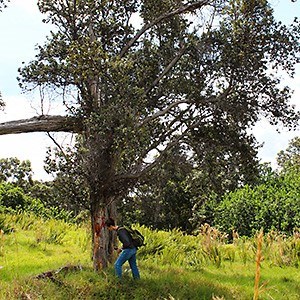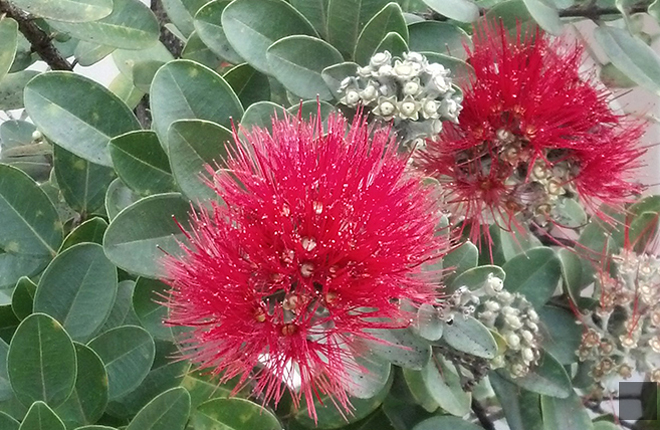ARS Targets Tree Blight in Hawaii
Agricultural Research Service (ARS) plant pathologist Lisa Keith is part of a rapid-response team of federal and state partners in hot pursuit of a marauding fungus that’s attacking Hawaii’s beloved ʻōhiʻa (oh-HEE-ah) trees. Fortunately, the team’s efforts are paying off with important new leads and tools to counter the fungus.
 ARS plant pathologist Lisa Keith inspects an ʻōhiʻa tree for disease symptoms. (Wade Heller, D3735-1) |
The fungus, which the team identified in 2014 as Ceratocystis fimbriata, causes a vascular wilt disease called “Rapid ʻŌhiʻa Death” (ROD) that has killed hundreds of thousands of ʻōhiʻa trees in forests and residential areas on the Big Island of Hawaii, and it continues to spread, reports Keith.
The loss of the tree, known scientifically as Metrosideros polymorpha, poses a significant threat to the state. As a flagstone species of Hawaii’s native forests, the ʻōhiʻa tree plays a critical ecological role in maintaining watershed health and groundwater quality. The tree also provides habitat for rare and endangered species of plants, animals, and insects, and it figures prominently in native Hawaiian culture. For example, its powder-puff-like flowers are used in the colorful leis worn by locals and island visitors.
C. fimbriata has shown no mercy, however, killing saplings and mature trees alike. Studies led by Keith at the ARS Daniel K. Inouye U.S. Pacific Basin Agricultural Research Center in Hilo, Hawaii, showed that at least two new species of Ceratocystis kill ʻōhiʻa. The fungi can remain hidden within the trunks of afflicted trees for up to a year before symptoms appear. When that happens, the trees have just weeks to live—hence the name “Rapid ʻŌhiʻa Death.”
Keith’s lab is also working to narrow down the list of other plants that host the fungus. They’ve conducted growth-chamber experiments in which taro, syngonium, and other plants were exposed to the fungi and their reactions evaluated. She’s also keen to understand what genetic changes occurred in the two Ceratocystis species that made them so lethal to the ʻōhiʻa tree—and when those changes happened. This information will help determine the species’ origin, improve understanding of factors affecting their virulence, aid development of methods to minimize these factors, and generate additional knowledge needed to limit future introductions of Ceratocystis, says Keith.
Towards that end, she’s led the team’s development and use of molecular techniques to rapidly detect the ROD-causing species and distinguish them from other types of the fungus, aiding efforts to accurately diagnose the disease and monitor its spread, distribution, and severity. ROD has so far been restricted to the Big Island.
The rapid-response team is also exploring the role of ambrosia beetles, wood-boring pests suspected of spreading the fungus’s spores—and targets for potential chemical control.
Rapid ʻŌhiʻa Death caught the Big Island by surprise, but the researchers responded quickly. The information they’ve provided is already helping state officials, residents, property owners, and others take action to safeguard not only Hawaii’s remaining ʻōhiʻa trees, but their ecological contributions as well.
Keith’s collaborators on the rapid response team include Flint Hughes with the USDA Forest Service; James “J.B.” Friday, Gordon Bennett, Curtis Ewing, Marc Hughes, and Wade Heller of the University of Hawaii; and Carter Atkinson, Jim Jacobi, and Lucas Fortini of the U.S. Geological Survey. Other partners in the fight to save the ʻōhiʻa trees are Hawaii’s departments of agriculture and land and natural resources, as well as community members.—By Jan Suszkiw, ARS Office of Communications.
Key Facts
- ʻŌhiʻa trees are ecologically and culturally important to Hawaii.
- A fungus is rapidly killing ʻōhiʻa trees.
- ARS scientists and collaborators identified the fungus in 2014.
- The team developed detection methods to help prevent the fungus’s spread.
Full Story








